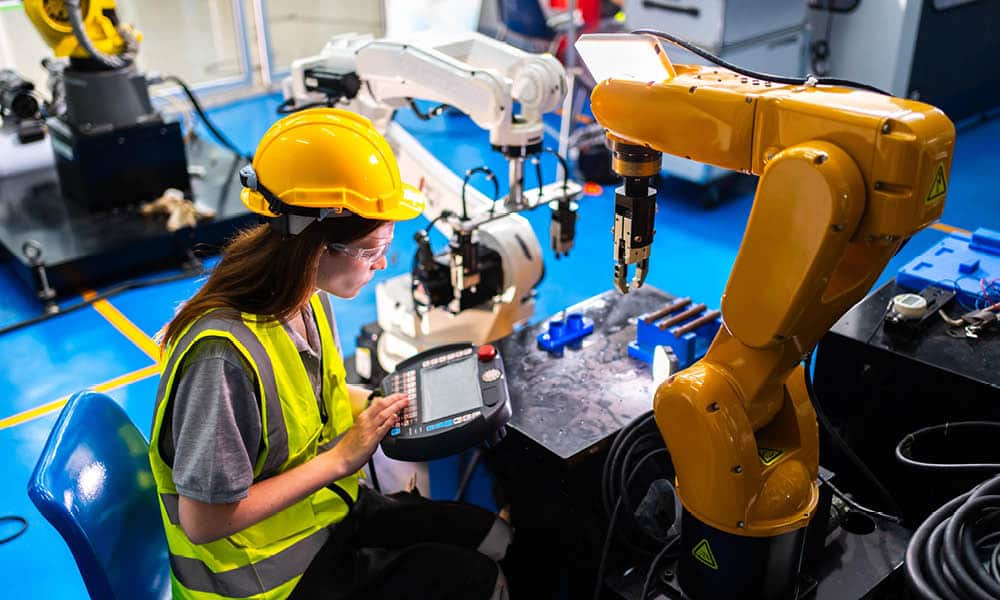Enabling Transformation with Smart Operations

Increasing visibility and speed of execution through Manufacturing 4.0 and connected systems are critical to meet manufacturers’ needs.

TAKEAWAYS:
● Manufacturers need digital tools and capabilities to address the increased business volatility that may impact their success.
● The key to success is how quickly manufacturers can identify and address the array of problems and opportunities that arise.
● Software systems that once enabled business transformation may now be a constraint, so manufacturers need updated technologies.
Manufacturing companies are continually balancing capability with opportunity. At the highest level, the challenges that manufacturers face today are the same as they’ve always faced—namely, how to deliver the best product or service at a cost that allows them to make a profit and invest in future opportunities. The new challenge manufacturers are now facing is how to address the significantly increased business volatility that can impact their success. Rapidly changing market dynamics, regulatory changes, technology advances, resource constraints, nationalism, and competitive pressures are forcing companies to react faster than ever before just to stay competitive. While many of these factors are not new problems, and every problem can be solved, developing an effective solution for addressing them simultaneously can seem like an unsurmountable challenge.
The key for success is how quickly manufacturers can identify and address the array of problems and opportunities that arise. Companies need to mitigate quality problems discovered in the field before they impact customers, margin, and future sales. They also need to identify potential shortages before they affect production. Manufacturers need to identify customer opportunities with material sourced before they lose out to the competition. They need to mitigate potential machine failures before they impact production. Moving too slowly can often make the solution worse than the problem. For example, building up too much inventory to address a shortage as the market starts to cool adds inventory and potential obsolescence costs.
Manufacturers may struggle to have the visibility they need to identify opportunities and challenges quickly. Manual processes and disconnected systems not only make visibility difficult, they can also make the rapid analysis and remediation required painfully slow. In such instances “heroes” are born: they make a phone call, call in a favor, work endless overtime hours, pay expediting costs, or throw additional resources at the problem to get to a resolution. These workarounds can be costly, cause disruption, and are normally not sustainable for long periods of time.
“Connectivity enabled through modern technology, strong organization, and innovative leadership enables a manufacturer to respond faster and more efficiently.”
Manufacturing 4.0 promises to help address these issues. Connectivity enabled through modern technology, strong organization, and innovative leadership allows a manufacturer to respond faster and more efficiently. Digitalization of the business provides the path to minimize the lag between the discovery of problems and execution of solutions. Optimizing the entire business requires a connected enterprise. This connection enables the visibility required to execute faster. Connecting engineering to manufacturing with a common product master enables faster and more accurate execution. Enabling a seamless flow between product engineering, manufacturing, quality, suppliers, supply chain, sales, and service enables digital execution between business processes. Looking at the business holistically as a connected enterprise enables smart operations.
With the advent of artificial intelligence (AI) and the dependency on data for better results, data availability and quality are becoming ever more critical. While manufacturers have been using predictive AI for years to predict machine failure and optimize production, they’re now using generative AI to improve quality and manufacturing efficiencies. To maximize the benefits and opportunities of AI for manufacturing, the next step will be to bring the operational technology data (OT) and back office/information systems (IT) data together so that correlations, predictions, and recommendations can be more accurate. Having a common platform that brings these data together enables an operator, supervisor, or maintenance technician to have visibility of their business and make better decisions faster. Persona-based workbenches enable the user to obtain the exact information required at the time required. The objective is to provide the information and tools necessary to better understand “their business” and be able to execute as required. The result will be users that are more productive, capable, and accountable to the business.
For many, software systems have served as a critical enabler of this business transformation, but they can also sometimes impede further progress on the journey. This has been the case for manufacturers that have selected systems that optimize specific areas of the business without taking into consideration the holistic need for a complete business transformation. Disconnected systems and complex integrations that once enabled a business may not have the capabilities and functionality needed to support new business models or adapt to rapidly evolving business requirements. With the immense effort required to make changes, IT and the systems that support them have often become a business constraint rather than an enabler. Modern cloud native enterprise applications have helped to address these issues by providing integrated platforms that are also updated continually. Manufacturers can take advantage of newly embedded capabilities and technologies such as AI as they evolve without requiring a reimplementation.
While most rightfully see Manufacturing 4.0 or Industry 4.0 as a journey vs. a destination, many companies feel as though they have not progressed as much as they would like. The World Economic Forum found that more than 70 percent of companies that invested in Industry 4.0 projects failed to get the benefits anticipated. Why is this so difficult? What can be done to increase success?
“Success is determined by how much time and what level of resources manufacturers need to identify any problems or opportunities and be able to adequately address them.”
The challenge for many companies is that their Industry 4.0/digitization projects are managed in silos. Similar to an assembly line or manufacturing constraints shared in Eliyahu Goldratt’s book The Goal, only optimizing a part of the business implies that the business is still constrained. The real value comes with connectivity between the lines of business. A manufacturer may find it useful to use real-time machine data to help predict machine failures and production progress to then manually create a maintenance order. However, using that data to have the system automatically order maintenance parts, plan a maintenance order, and adjust production schedules is even better. Being able to simultaneously and automatically notify the machine supplier so that they can improve their quality takes it even further.
How companies measure their Manufacturing 4.0 progress is another challenge. A snapshot in time is not necessarily the best indicator of digital transformation success. A successful transformation is really about the ability for a manufacturer to support constant innovation, continual improvement, and the capability to effectively address whatever challenges or opportunities that arise now or in the future. For these manufacturers, the better measurement is their ability to act, not just their performance improvement at any point in time. If they have transformed effectively, they have the visibility necessary across the organization, access to tools to analyze data quickly, and the capability to execute on that information. Success is determined by how much time and what level of resources manufacturers need to identify any problems or opportunities and be able to adequately address them. The ability to do so in the best way possible is a part of the Manufacturing 4.0 journey leading to smart operations and the ability for manufacturers to successfully address the ever-evolving business volatility. M
About the authors:

John Barcus is GVP Manufacturing Industries Strategy and Advanced Technologies at Oracle Corporation.